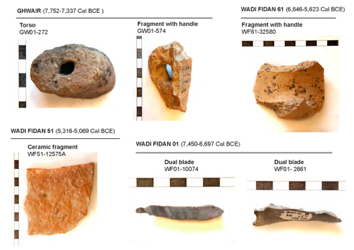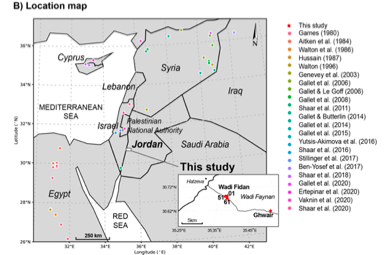Defined the Earth’s magnetic field in the Middle East between 10,000 and 8,000 Years ago. The results offer new insights into the current magnetic field.
An international team of researchers from the Istituto Nazionale di Geofisica e Vulcanologia (INGV), Tel Aviv University (Israel), the Council for British Research in the Levant (CBRL), and the University of California San Diego (USA) analyzed pottery and flint from four archaeological sites in Jordan.

The research team found that between 10,000 and 8,000 years ago the magnetic field strength in the Middle East region was among the weakest in the Holocene and lower than or similar to the present magnetic field. A weak magnetic field implies a weakening of the shielding effect of solar radiation with greater penetration of solar-energy particles and cosmic rays towards the Earth’s surface.
The new study deepens our knowledge of the magnetic field in the past to understand the behavior of the current magnetic field, characterized by marked weakening. The results of the study “The strength of the Earth’s magnetic field from Pre-Pottery to Pottery Neolithic, Jordan” were published in the journal PNAS.

“The Earth’s magnetic field”, explains Anita Di Chiara, INGV researcher and co-author of the study, “has changed significantly in the past. Accurate datasets from the past provide a tool to understand the present, as well as a valid dating method that can be used as an alternative to the radiocarbon method”.
“Ceramics and flint were examined”, continues Di Chiara, “from archeological sites previously dated through the method of Carbon 14 (radiocarbon). We used paleointensity techniques to define the intensity of the magnetic field of the past. Flints are stone objects, such as arrowheads or blades worked with fire to make them sharp and when these materials cooled down. Through the firing process, the magnetic minerals contained in them oriented themselves with the existing magnetic field which, in this way, was registered in the analyzed tools. We went in search of this “imprinted” information and discovered that in the oldest site, dating back to 10,000 years ago, the magnetic field was similar to or lower than the magnetic field present”.
“This result”, continues the researcher, “is important because even the current magnetic field is almost the lowest in the Holocene (current geological epoch). The research methodology used provides a powerful dating tool because any object whose archaeological age we do not know can be analyzed with the technique of paleomagnetism and archeointensity: by defining an archaeomagnetic secular variation curve of the magnetic field intensity for the last thousands of years it is possible to ascribe the objects to a specific archaeological period. This aspect is also particularly useful to climate and environmental researchers also because the intensity of the current magnetic field shows a decreasing trend”.
The study through the paleointensity technique combined with archeology is called archaeomagnetism.
“The research continues”, concludes the researcher. “We hope to collect further data on these sites in order to extend the curve of variations in the intensity of the terrestrial field in the past, also through the analysis of stone objects, used long before ceramics”.

